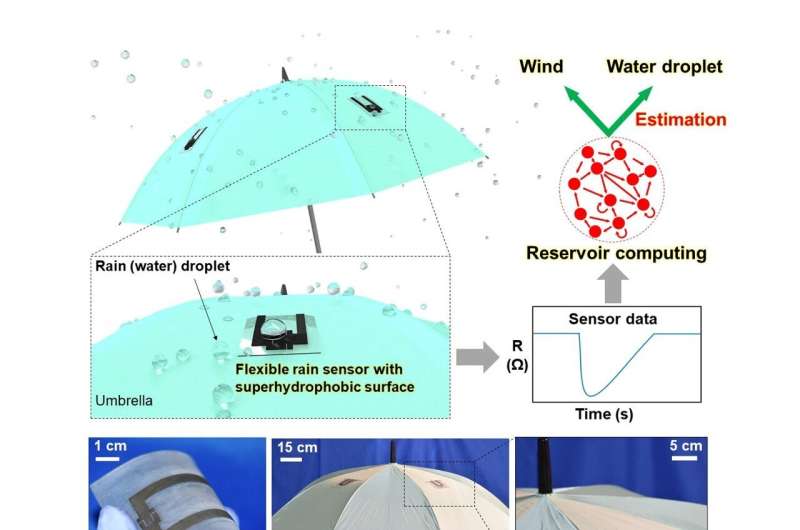Next-generation weather reporting: Versatile, flexible, and economical sensors

Have you ever been trapped in an unexpected torrential downpour? Weather forecasting systems have always tried to anticipate adverse weather events. These systems, however, are heavily dependent on bulky, stationary, expensive equipment such as weather radar, impeding timely updates on local weather conditions for personal use. Tackling this gap in knowledge and practicality, a research team from Osaka Metropolitan University and the University of Tokyo developed an attachable and lightweight sensor sheet that features a flexible resistive sensor and a reservoir computing analysis.
This single device allows simultaneous real-time measurement of raindrop volume and wind speed, reporting weather information when attached to umbrellas, cars, or houses. Research lead Professor Kuniharu Takei of Osaka Metropolitan University noted, “The findings open up a promising economical approach to weather reporting, contributing to disaster preparedness and greater community safety.”
To determine rain volume, the sensor measures the electrical resistance generated when a raindrop hits its surface. It is protected by a superhydrophobic silicone sheet of polydimethylsiloxane (PDMS), which is infused with graphene and further processed with a laser. The superhydrophobic silicone repels water droplets, ensuring the durability and stability of the sensor. Laser texturing allows constant control and measurement of the behavior of water droplets, be they staying, sliding, bouncing, or splitting on the sensor surface.
The sensor can be easily fixed to a wide range of surfaces and remains functional when flat or bent. Testing changes in rain volume estimations with the sensor mounted at various angles showed no significant differences, suggesting that the sensor can be attached to hand-carried items such as umbrellas. If widely adopted, it would be possible to obtain mass data that enables the development of real-time local weather maps.
Wind speed has a significant effect on water droplet behavior, indicating the need to measure wind speed at the same time as raindrop volume. Conventionally, measuring multiple pieces of weather data requires multiple sensors, increasing power consumption. Going beyond this traditional practice, the researchers made use of a machine learning algorithm called reservoir computing (RC) to analyze the output data. Changes in rain and wind conditions resulted in resistance changes, which were detected by the sensor and then recorded as time-series data. Such data was used to train the machine, which predicted the pattern and reported rain volume and wind speed as output information.
Even though there is still more work to be done to further improve its accuracy, the sensor is expected to be a mainstay of next-generation weather sensing. The study, published in Advanced Materials, progresses the United Nations Sustainable Development Goals on resilient infrastructure, sustainable cities, and climate action. “We believe this device can contribute to realizing the ultimate Internet-of-Things society, which is safe, secure, comfortable, and disaster-free,” concluded Professor Takei, “and we would like to engage actively in industry-government-academia collaboration that promotes such practical applications.”
Folding design leads to heart sensor with smaller profile
Seiji Wakabayashi et al, A Multitasking Flexible Sensor via Reservoir Computing, Advanced Materials (2022). DOI: 10.1002/adma.202201663
Provided by
Osaka Metropolitan University
Citation:
Next-generation weather reporting: Versatile, flexible, and economical sensors (2022, May 13)
retrieved 13 May 2022
from https://techxplore.com/news/2022-05-next-generation-weather-versatile-flexible-economical.html
This document is subject to copyright. Apart from any fair dealing for the purpose of private study or research, no
part may be reproduced without the written permission. The content is provided for information purposes only.
For all the latest Technology News Click Here
For the latest news and updates, follow us on Google News.

